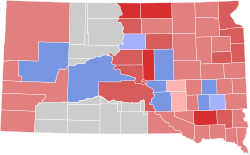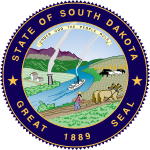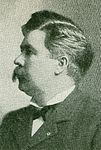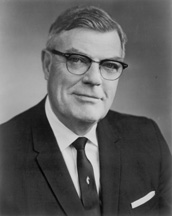
Joseph Henry Bottum was an American politician. He served as the 27th Lieutenant Governor of South Dakota and as a member of the United States Senate from South Dakota.
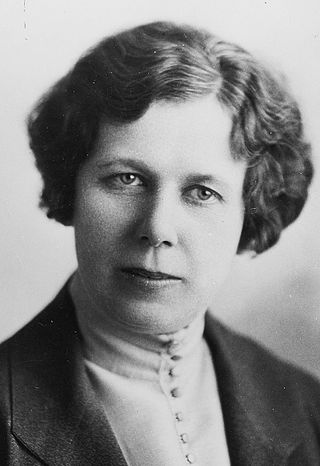
Gladys Shields Pyle was an American educator and national record setting female politician during the first score of years post-ratification of Women's Suffrage Amendment to the U. S. Constitution, who set numerous national and state partisan electoral records before the age of 50, including at least a dozen national records related to her 1938 U. S. Senate election. Her most significant national electoral records are:
- First female nationally to enter the U S Senate through election (1938) and first to do so in her own right at the age of 48. She ran 5.6% ahead of the second highest vote getter for any statewide office in her state in that election.
- First female nationally to run for both governor and U.S. Senate and first to do so in her own right.
- First female nationally to be elected to both a state constitutional legislative office (1922) and a state constitutional executive office (1926) in any state and first to do so in her own right. Only female nationally to be both the first elected to a state constitutional legislative office and the first to be elected to a state constitutional executive office in any state.
- First female nationally to receive more votes cast than had been received by any other statewide candidate since statehood in any state (1928).
- Second female nationally to receive both the highest percentage of the vote received of all statewide candidates and most total raw votes received of all statewide candidates in a general election in any state (1928) and first female to do so since ratification of the Suffrage Amendment in any state.

William Henry McMaster was an American politician who served as the tenth Governor of South Dakota from 1921 until 1925. A member of the Republican Party, he went on to serve as a member of the United States Senate from South Dakota from 1925 to 1931.
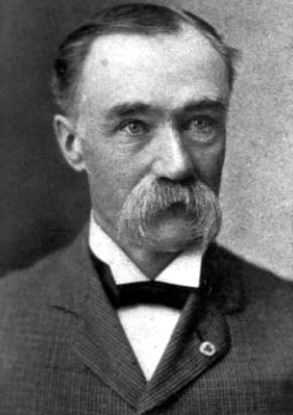
Andrew Ericson Lee was an American politician who served as the third Governor of South Dakota.

The 2010 United States House of Representatives election in South Dakota took place on Tuesday, November 2, 2010. Voters selected a representative for their single At-Large district, who run on a statewide ballot. On June 8, 2010, the Republicans nominated Kristi Noem, Assistant Majority Leader of the South Dakota House of Representatives and the Democrats nominated the incumbent Stephanie Herseth Sandlin. B. Thomas Marking ran as an Independent candidate. In the general election, Noem defeated Herseth Sandlin, winning 48.1 percent of the vote to 45.9 percent for Herseth Sandlin.

The 2004 South Dakota's at-large congressional district special election, which was held on June 1, 2004, was triggered by the January 20, 2004 resignation of Republican Representative Bill Janklow following a conviction of vehicular manslaughter after an accident that had occurred in August 2003. Each party held a nominating convention to choose their nominee for the special election. Republicans nominated Larry Diedrich over Barbara Everist, also a South Dakota State Senator. Democrats chose attorney Stephanie Herseth, who had unsuccessfully challenged Janklow in 2002.

The 1889 South Dakota gubernatorial election was held on October 1, 1889, to elect the first Governor of South Dakota. Territorial Governor Arthur C. Mellette received the Republican nomination and faced former Territorial Commissioner of Immigration P. F. McClure, the Democratic nominee, in the general election. Mellette defeated McClure in a landslide.

The 1894 South Dakota gubernatorial election was held on November 6, 1894. Incumbent Republican Governor Charles H. Sheldon ran for re-election to a second term. Despite facing a thread of defeat at the Republican convention, Sheldon was renominated unanimously. In the general election, he faced Populist nominee Isaac Howe, a Spink County Judge; James A. Ward, the former state chairman of the South Dakota Democratic Party; and Prohibition nominee M. D. Alexander. The election was largely a replay of the gubernatorial elections of 1890 and 1892, with the Farmers' Alliance candidate placing second and the Democratic nominee placing a distant third. This time, however, Sheldon won an outright majority and the Democratic Party's vote share shrunk to just 11%, its worst performance in state history.
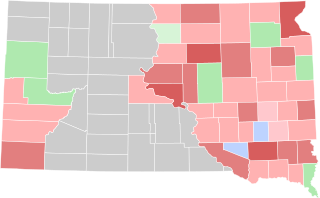
The 1892 South Dakota gubernatorial election was held on November 8, 1892. Incumbent Republican Governor Arthur C. Mellette declined to seek re-election to a third term. Former territorial legislator Charles H. Sheldon was nominated by the Republican Party as Mellette's replacement, and he faced former legislator Abraham Lincoln Van Osdel, a leader in the South Dakota Farmers' Alliance and the nominee of the Independent Party, along with Democratic nominee Peter Couchman, in the general election. The result was largely a replay of the 1890 election, with Sheldon winning by a large margin, but only a plurality, and Van Osdel taking second place over Couchman.

The 1896 South Dakota gubernatorial election was held on November 3, 1896. Incumbent Republican Governor Charles H. Sheldon declined to run for re-election to a third term. Former Secretary of State Amund O. Ringsrud was nominated as Sheldon's replacement at the Republican convention. Ringrud's main opponent was businessman Andrew E. Lee, who was nominated by a makeshift coalition of Populists, Free Silver Republicans, and Democrats. In the general election, Lee narrowly defeated Ringsrud, the first defeat for the Republican Party in a gubernatorial election since statehood.

The 1902 South Dakota gubernatorial election was held on November 4, 1902. Incumbent Republican Governor Charles N. Herreid ran for re-election to a second term. He faced former Watertown Mayor John W. Martin, the Fusion nominee who was listed as the Democratic nominee, in the general election. Herreid defeated Martin in a landslide to win his second term.

The 1898 South Dakota gubernatorial election was held on November 8, 1898. Incumbent governor Andrew E. Lee, elected in 1896 as a Populist, he ran for re-election as a Fusion candidate. He was challenged by Republican nominee Kirk G. Phillips, the state treasurer. Lee narrowly defeated Phillips to win his second term as governor, but most of his Fusion allies lost their elections, leaving him as the lone statewide officeholder.

The 1904 South Dakota gubernatorial election was held on November 8, 1904. Incumbent Republican Governor Charles N. Herreid declined to run for re-election to a third term. Clark County State's Attorney Samuel H. Elrod won the Republican nomination to run as Herreid's successor, and he faced Democratic nominee Louis N. Crill, the former president of the state Senate, and former U.S. Congressman Freeman Knowles, the Socialist nominee. For the first time since 1894, the Democratic and Populist Parties nominated separate candidates. Ultimately, the split in the two parties did not prove dispositive; Elrod defeated Crill and the other candidates in a landslide.

The 1906 South Dakota gubernatorial election was held on November 6, 1906. Incumbent Republican Governor Samuel H. Elrod ran for re-election, but was defeated for renomination at the Republican convention by former Attorney General Coe I. Crawford. In the general election, Crawford was opposed by the Democratic nominee, former State Representative John A. Stransky of Brule County. Crawford had little difficulty defeating Stransky in a landslide, largely matching Elrod's margin of victory from two years earlier.
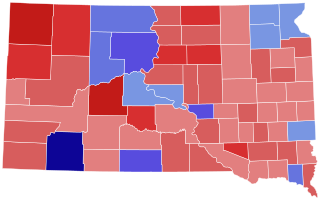
The 2018 South Dakota Attorney General election was held on November 6, 2018. Incumbent attorney general Marty Jackley was term-limited and ran for Governor of South Dakota. In June 2018, the South Dakota Republican party nominated Jason Ravnsborg for attorney general and the Democratic party nominated Randy Seiler. Ravnsborg won the election to become the 31st attorney general of South Dakota.

John L. Pyle was an attorney and politician from the state of South Dakota. A Republican, he was notable for his service as State's Attorney of Hand County (1886-1888) and state Attorney General (1899-1902).

Melvin Grigsby was an American attorney, politician, and military leader from South Dakota. A Union Army veteran of the American Civil War, Grigsby was most notable for his service as South Dakota Attorney General and an organizer and commander of the 3rd United States Volunteer Cavalry Regiment during the Spanish–American War.
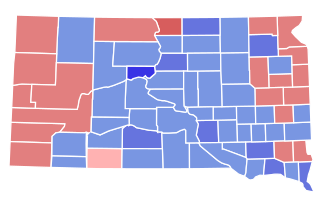
The 1928 South Dakota gubernatorial election was held on November 6, 1928. Incumbent Democratic Governor William J. Bulow ran for re-election to a second term. In the general election, he faced Attorney General Buell F. Jones, the Republican nominee. Despite Republican presidential nominee Herbert Hoover overwhelmingly defeating Democratic nominee Al Smith overwhelmingly in South Dakota, Bulow defeated Jones by a decisive margin to retain the governorship. In so doing, he became the first Democratic candidate for Governor to receive a majority of the vote in the state's history.

The 1930 South Dakota gubernatorial election was held on November 4, 1930. Incumbent Democratic Governor William J. Bulow declined to run for re-election to a third term, instead opting to successfully run for the U.S. Senate. The Republican nomination was hard-fought and the primary was crowded; because no candidate received 35% of the vote, state law required that the nomination be decided at a state party convention. There, former State Senator Warren Green, the last-place finisher in the primary, defeated Secretary of State Gladys Pyle, the plurality winner. In the general election, Green faced D. A. McCullough, the state's Rural Credits Commissioner and the Democratic nominee. Despite Bulow's success in the preceding two elections, Green defeated McCullough by a decisive margin—even as Bulow himself was elected to the U.S. Senate.

The 1942 South Dakota gubernatorial election was held on November 3, 1942. Incumbent Republican Governor Harlan J. Bushfield declined to seek re-election to a third term and instead successfully ran for the U.S. Senate. A crowded Republican primary developed to succeed him, and because no candidate received 35% of the vote, the nomination was decided at the state Republican convention, where former Attorney General Merrell Q. Sharpe, the second-place finisher in the primary, won the nomination. In the general election, Sharpe faced Democratic nominee Lewis W. Bicknell, the 1940 Democratic nominee for governor. Aided by the national Republican landslide, Sharpe defeated Bicknell in a landslide.
